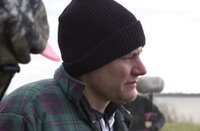
Brian Jun, writer/director, STEEL CITY
Jun's script for this film was a screenplay finalist at the 2003 Austin Film Festival.
Briefly describe the film.
The film is set in a fictional Midwestern steel town, concerning two working-class brothers, PJ (Tom Guiry) and Ben (Clayne Crawford). Ben and PJ must cope with the aftermath when their father (John Heard) gets incarcerated due to a deadly car accident--especially PJ, the youngest son, who was involved. As PJ comes to terms with a broken family, negligent brother, and a stern uncle, he is forced to re-evaluate his own lackluster life and his pending role as a man in his own respect.
How did the initial idea for this story come about? How did it develop?
After moving to Los Angeles in 2001, I wrote numerous screenplays in the midst of working a healthy dose of miserable day jobs, which only led to more day jobs and little success. So I decided to go back to the Midwest and tell a simple story that could be made on a conservative budget. I started writing dramatic scenes between an incarcerated father and his grown son, whom he abandoned years earlier. Within these scenes, a plot emerged, and I became bold enough to pool all my limited resources together and make the film under any and all circumstances.
What are some scenes or moods in other films that have made an impression on you?
Without a doubt, the work of Ken Loach and his gritty film Sweet Sixteen. American cinema from the '60s and '70s; Five Easy Pieces and its blue-collar Americana; the transient nature that Midnight Cowboy offers. Themes of loneliness and generational relationships are also extremely palpable in Steel City.
What atmosphere or style did you want to create, and how did you go about creating it?
I certainly wanted it to be bleak and desperate, which is why I set it during the winter. My cinematographer (Ryan Samul) and I decided on a blue pallet for most of the scenes to illustrate the working-class environment. We shot tungsten film for all the exterior scenes and let it go uncorrected, overexposing a full stop to get the most out of the 16mm stock. We used this technique for most of the interior scenes as well.
How long did it take to shoot? Were there any memorable or unexpected moments on the set?
18 principle days, 2 days of second unit. In all honesty, most everything went as planned. We had a great crew, great actors, and there were not too many surprises. The name of the game is planning when you're making a film like this, because you don't have the money, time, or resources to correct it on the next day.
Has the finished product caused you to see what you wrote in a different way?
Sure. It allowed me to see all my mistakes, but in a positive way. Making a feature under these circumstances helped me to understand I have the work ethic to make it happen, and has allowed me to grasp what translates well from script to screen, since I served as both writer and director. It's a different ballgame once you hire a crew, actors, and put a camera on a dolly... there's very little time to think.
The narrative feature STEEL CITY will be screened at 7:15 pm on Saturday, Oct. 21, and at 9:15 pm on Tuesday, Oct. 24. Film passes to the Austin Film Festival are just $35 for admission to all screenings (space permitting).



No comments:
Post a Comment